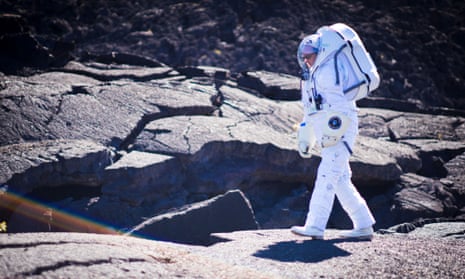We holidayed in Cornwall and France again this year, as we do every year. And I’m thinking next year we might do something different. Been looking into options, from Ibiza to the Norfolk Broads. Or maybe Mars, in which case this Horizon: Mars – A Traveller’s Guide (BBC2) will be useful. It won’t be long before it happens; many scientists think the first person to set foot on the red planet is alive today.
The programme is handily divided into sections: getting there, what to do and see etc. With experts. Spacecraft structures engineer Abbie Hutty explains the journey. Not entirely surprisingly it isn’t easy, rocket science. The landing especially, with temperatures of 1750C generated as you enter Mars’s atmosphere. Don’t forget your heat shield. Then there are the ferocious winds and the dust. Oh, and the journey takes seven months. Bloody hell, we find the seven-hour drive to Cornwall a challenge, seven months is going to be a nightmare. I spy with my little eye something beginning with “S”… Star? ... Yup.
What to wear then? You have to be prepared for temperatures that can drop to -126C, for the radiation and the lack of oxygen, for meteorite showers and dust storms that last for weeks at a time, for atmospheric pressure so low your blood will boil (I mean literally, not just that you’d get really cross about it). So a space suit obviously, though the design hasn’t been finalised yet.
Luckily there are a bunch of people up a volcano in Hawaii testing them for you. They are also simulating being on Mars, researching performance, behaviour, food etc. What brand of chocolate bar would be a good one to take, for the trip I wonder? Snickers?
Right, so when you’re there, where to go? They’re really pushing the Valles Marineris, which is like the Grand Canyon only bigger and better. The Grander Canyon. And without any tacky visitors centres. Don’t bother packing your swimmers though; there isn’t any liquid water there. Or indeed anywhere – hasn’t been for years (approximately three and a half billion of them).
Also worth visiting: a big crater called Gale, with its central peak, Mount Sharp (which isn’t, quite rounded in fact), and the lava flow tubes on the Pavonis Mons volcano. The Tharsis region is spectacular, and boasts, in Olympus Mons, not just the highest volcano on Mars but the highest in our entire solar system. Yes, it is all about rocks, volcanoes and craters, so it helps if you are into geology rather than, say, water parks and pub crawls. Brilliant views, though, narrator Mark Gatiss keeps saying. Gatiss is now working part-time for the Mars Tourist Board. “What an incredible and enigmatic stop on your adventure across Mars,” he says. And you’ll be “waxing lyrical about the epic wonders you’ve seen” in the postcards you’ll be posting home via radio telescope. Hey, A Human Sends A Postcard Home, there’s an idea for a poem in there somewhere.
Sports enthusiasts, be wary of what looks like snow at the southern polar region; this is solid carbon dioxide, also known as dry ice. Go there for the 1980s nightclub experience, but wrap up – it gets really parky. And, obviously, watch out for sailors fighting in the dance hall.
What about the big question: Is There Life? Well, obviously you would have heard about it if any had been found (“or would you?” say the conspiracy theorists). And the planet has been quite thoroughly explored. But astrobiologist Prof Charles Cockell isn’t ruling it out – suggesting the Terra Sirenum area of the remote southern highlights as the place to go looking; it has the best conditions. But if you are after a holiday romance with a little green man or woman, you are probably going to be disappointed. Life on Mars – or any remnant of it – is more likely to take the form of microbes in ancient salt deposits.
You know what, I think we’ll wait. Maybe Greece next year, and take it from there.
I like John in The 100 Year Old Driving School (ITV). John, 102, drives on the wrong side of the road in order to see what’s coming. “I wander across a bit, to get a better view,” he says. Good idea.
The instructor assessing him, points out the cars parked in the road ahead. “What’s that going to mean to us?” he asks, hoping to elicit something about taking extra care, watching out for doors opening or people stepping out from between them. “It means they haven’t got garages,” says John.
Now hurry along. No, not you John, but Google, Apple, all the motor manufacturers, everyone working on driverless cars.

Comments (…)
Sign in or create your Guardian account to join the discussion